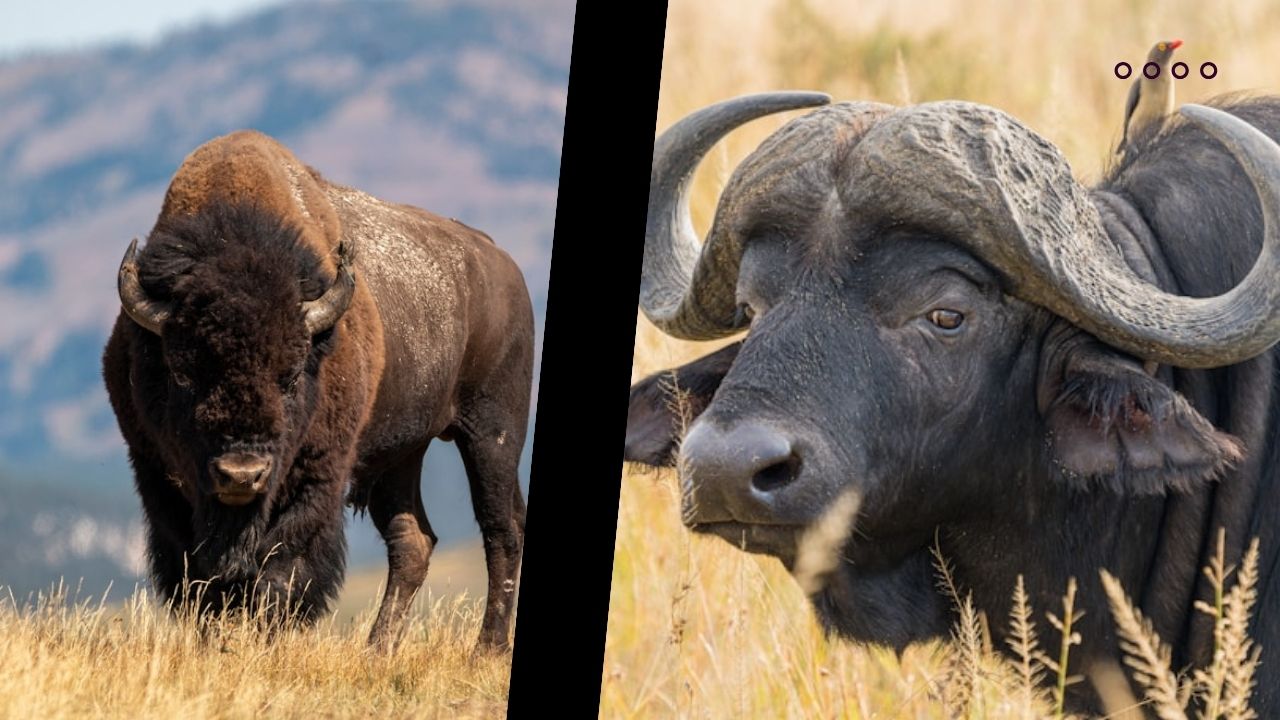Who would win in a fight between an African Cape Buffalo and an American Bison? The animal that most Americans call a buffalo is actually a bison. Buffaloes are found in Africa and South Asia, while bison roam in North and South America. Both the buffalo and bison are in the Bovidae family, which also includes other cloven-hoofed ruminants, like goats.
The Cape Buffalo, also known as the African Buffalo is a bovine species from Africa that are known for their massive body and unpredictably aggressive and revengeful demeanor, and hence, widely considered as a very dangerous animal.
This is also the reason why man has never tried to domesticate these animals. American Bison are colossal mammals of North America and symbolic of the Great Plains. The present regard for this species is a result of the recognition and appreciation given to it by the Native Americans.
BUFFALO Vs. BISON: Size and Description
The Cape buffalo is not very tall— it stands only 51–59 inches 130–150 cm (130–150 cm)and has relatively short legs—but it is massive, weighing 935–1,910 pounds (425–870 kg).
Bulls are about 220 pounds (100 kg) heavier than cows, and their horns are thicker and usually wider, up to 40 inches (100 cm) across, with a broad shield covering the forehead. The coat is thin and black, except in young calves, whose coats may be either black or brown.
The body is heavy-set, with stocky legs, a large head, and short neck. There are no distinct markings on the body and the ears are large and tend to droop; The American bison is the largest mammal in North America.
It grows to 7 to 11.5 feet (2.1 meters to 3.5) long from head to rump, and its tail adds an extra 20 to 23.5 inches. They weigh 930 to 2,200 lbs. (422 to 998 kilograms).
Two distinctive features of bison are the shoulder hump and their huge head. Fur color is brown, varying slightly from the front and back of the animal. The hair is longer in the front than in the rear.

The distinction between hair length is most noticeable in males. The horns are black, curving upward and inward and ending in a sharp tip. The hooves are black and circular in shape. Range and Habitat
One of the most successful of Africa’s wild ruminants,the Cape buffalo thrives in virtually all types of grassland habitat in sub-Saharan Africa,from dry savanna to swamp and from lowland floodplains to montane mixed forest and glades, as long as it is within commuting distance of water.
It is immune to some diseases that afflict domestic cattle in Africa in particular, the bovine sleeping sickness transmitted by tsetse flies.
However, the Cape buffalo is susceptible to cattle-borne diseases. In the 1890s a rinderpest plague swept the African continent from Ethiopia to the Cape of Good Hope and killed up to 90 percent of the buffalo, as well as many antelopes.
This species is most commonly found on open plains. They also frequent river valleys, grasslands, semiarid lands, and prairies.
Some will also roam into foothills and mountainous areas, though they are not considered to be high-altitude creatures. While there are approximately 500,000 animals kept contained on private land, only 15,000 are estimated to be truly wild and free-range.
Historically this species roamed from northern Mexico to Canada, but today they are restricted to tiny pockets of habitat. There is a herd in Mexico, a number of fragmented herds in the United States, and a number of fragmented herds in Canada.
BUFFALO Vs. BISON: Diet
To sustain its bulk, the Cape buffalo must eat a lot of grass, and therefore it depends more on quantity than quality. It is able to digest taller and coarser grass than most other ruminants, has a wide muzzle and a row of incisor teeth that enable it to take big bites, and can use the tongue to bundle grass before cropping it—all bovine traits.
When grass is scarce or of too poor quality, buffaloes will browse woody vegetation. Bison are herbivorous mammals, which means that they feed primarily on plants. They are mostly grazers that eat grasses and sedges rather than searching for fruit or other plants.
This means that during the winter food can be hard to come by as it gets blanketed in snow. When snow covers the grasses, these massive creatures use their muscular necks to scrape down to the buried food below.
On average, bison ingest 1.6% of their body mass per day of dry vegetation. Bison require water every day as well.
BUFFALO Vs. BISON: Behavior
Savannah buffalo live in large herds of 50-500 animals, comprised of smaller subgroups of bachelor males, females and their young, or juveniles. Old males may be solitary.
African buffalo may be active throughout the day and night; on average, 18 hours per day are spent foraging and moving. Mainly preyed upon by lions. When a herd member is attacked, others will rush to its defence. Collectively a number of buffalo are more than capable to stave off an attack by an entire pride of lions.
A wounded buffalo bull is regarded as most dangerous by hunters, and is one of the reasons why this animal is included into the so-called ‘big five’. This trait is the origin of many hunting adventures, myths and legends.Bison are gregarious animals and are arranged in groups according to sex, age, season, and habitat.
Cow groups are composed of females, males under three years of age, and a few older males.More males enter these groups as the rut approaches. Males live either individually or in groups that may be as large as 30. Dominance between the bulls is linear.
Bulls that have a higher rank in the society breed more often than those of a lower rank. Grazing takes place during several periods each day and is conducted in loose groups. When bison travel, they form a line. The traveling pattern of bison is determined by the terrain and habitat condition.
Bison are good swimmers as well as runners, capable of reaching speeds of 62 km/hr. Copulation is initiated by the bull and is quick. During the rut, bulls fight among themselves. The amount of wallowing and tree horning also increases during the rut.
Now let’s come to the big question.
Between the American bison and the African Cape buffalo who can win in the event of a fight. As stated already both animals are bovids but there are differences in physical appearance.Buffalo are generally much bigger than bison, and in any fight mass is a huge factor in victory, especially for tanks like these.
Buffalo are also much more aggressive and put up with a wider array of threats. Bison deal with wolves,but buffalo deal with wild dogs which are arguably a bigger threat as well as lions and leopards.
They are arguably more well equipped to deal with predatory threats. In a fight with a bison, the buffalo will most likely win the fight due to its aggressive and unpredictable behavior, while on another hand, Bison is more muscular, stalky and stronger bone structure. At equal mass it’s closer, but the buffalo has an advantage considering its aggressiveness.
Read More Articles at our Content Database

